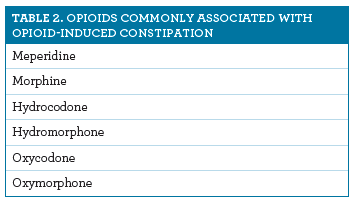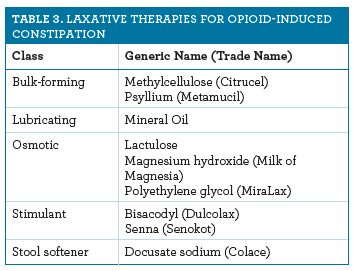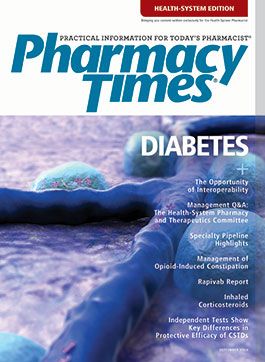Publication
Article
Pharmacy Practice in Focus: Health Systems
Management of Opioid-Induced Constipation
Prescription opioids are potent pain-relieving medications that, when used correctly, can effectively control pain and increase quality of life for patients with acute or chronic pain.

Prescription opioids are potent pain-relieving medications that, when used correctly, can effectively control pain and increase quality of life for patients with acute or chronic pain. However, optimal pain relief can be difficult to achieve due to the numerous adverse effects (AEs) of opioids, the most common of which are gastrointestinal.1,2 Most patients on opioids experience one if not more of the AEs during the course of therapy1 (Table 1). Constipation or opioid-induced constipation (OIC) is by far the most prevalent and persistent AE, with some estimates being as high as 40% in patients receiving opioids.1-4 Failure to prevent, recognize, or treat OIC can pose challenges in achieving pain therapy goals. Consequently, patients suffer a decreased quality of life, an unwarranted increase in health care costs, and, ultimately, discontinuation or unnecessary alteration of therapy.1,3,4 As one of the most readily accessible health care professionals, pharmacists are in a prime position to properly counsel patients on their medication use, the AEs, and effective prevention techniques.

Opioid analgesics (Table 2) act on specific receptors found in various places in the body, primarily in the central nervous system. These receptors not only control the pain relief mediated by these medications but also mediate the AEs associated with constipation.2 Mu receptors or mu-opioid receptors within the gastrointestinal (GI) tract are what readily cause OIC to develop in patients.1 When the mu receptor is activated, the coordinated rhythmic contractions required for intestinal motility and mucosal secretions are greatly decreased. This decrease in peristalsis, combined with reduced secretions in the gut and increased reabsorption of fluid from the gut, contributes to the formation of dry, hard stools that are difficult to expel. Patients with OIC usually present with complaints of hard stools, straining, and abdominal distension. Patients may complain of nausea and vomiting that may be treated with an antiemetic or anticholinergic, which may further irritate a patient’s condition.
Treatment options for OIC may be as simple as dietary alterations or as complicated as a bowel management program involving several medications to manage this debilitating and sometimes harmful AE. Lifestyle changes or nonpharmacologic intervention for prevention of OIC are typically recommended when opioid-centered treatment is initiated.1,4 Although simple lifestyle changes are unlikely to completely prevent OIC,1 these changes can be extremely beneficial, depending on how a patient initially reacted to a prescribed opioid and on the severity of the AEs. The recommended precautions patients should take are increased: dietary fiber, fluid intake, exercise, and physical activity. Lifestyle changes may not always be suitable for patients, or the changes may be ineffective. In these instances, pharmacists should be involved in recommending pharmacologic therapy.

Pharmacologic treatments for OIC have remained relatively constant. However, in recent years, with the increase in opioid use, there are increased efforts to inform patients and the entire health care team regarding the prevalence and severity of OIC. OIC is predominantly treated with OTC laxatives (Table 3) to help patients prevent OIC symptoms of from developing.1,4 Although these medications can be effective, it is necessary to understand their mechanism of action to select the most appropriate pharmacotherapy for patients.
The most common laxative OTC regimen for OIC combines a stimulant laxative and a stool softener.1 A stimulant laxative encourages bowel movements by directly stimulating peristaltic movement of the intestine via local mucosal irritation, thus increasing stool motility. The stool softener allows more water and lipids to penetrate the stool. This action aids in hydration and softening of the stool, facilitating natural defecation. Although stool softeners are typically well tolerated with minimal AEs, patients can have abdominal cramping while taking a stimulant laxative.
Bulk-forming laxatives, which are considered safe in most cases of constipation, can be harmful to patients with OIC. The lack of peristaltic movement caused by opioids, accompanied by fiber-increased fecal bulk, can exacerbate abdominal pain, and in some cases, contribute to bowel obstruction.
Lubricating laxatives or mineral oil can treat OIC through the inhibition of colonic absorption of fecal water and by softening the stool. The lubricating laxative should be used as needed and not daily, unlike the stool softener-stimulant combination.
Osmotic laxatives, which are slower working and sometimes take days to affect stool consistency, draw large amounts of fluid into the bowel. Common AEs of osmotic laxatives include dehydration, electrolyte abnormalities, and excessive fluid loss.
Although OTC laxatives are the mainstay first-line therapy for OIC, they do not affect the underlying mechanism.1 Consequently, for many patients, laxatives are completely ineffective for treating the symptoms.

As more patients use opioids and experience the associated AEs, there is a greater need for alternative therapies to mediate the AEs. In recent years, several prescription medications have been marketed to help mediate OIC in patients when OTC laxatives do not provide relief (Table 4). Most of these medications pinpoint OIC at its site of action, the mu receptor. Originally indicated for postoperative ileus prophylaxis, alvimopan (Entereg) has an off-label use for OIC. Alvimopan, like many other prescription medications for OIC, activates peripheral mu receptors restricted to the GI tract.3 Lubiprostone (Amitiza) has an indication for OIC but works differently compared with other medications.5 By activating certain chloride channels in the GI tract, lubriprostone promotes fluid secretion into the intestinal lumen. Methylnaltrexone (Relistor), another treatment option for OIC, was the first medication indicated for OIC that specifically targeted mu receptors in the GI area. Due to its lipid solubility, methylnaltrexone cannot penetrate the blood-brain barrier, thus the centrally acting pain-relieving effects of opioids are unaffected.6
Methylnaltrexone is currently only available as an injection. Naloxegol (Movantik) was approved by the FDA in 2014 for the indication of OIC. Similar to methylnaltrexone, naloxegol works by binding the peripheral mu-opioid receptors in the GI tract. It is a Pegylated derivative of naloxone, a quick-acting injection for the treatment of opioid overdose. Compared with naloxone, the presence of the pegylated moiety in naloxegol reduces its passive permeability across the blood-brain barrier. These new therapies have given patients newer, more selective treatment options when standard OTC laxatives fail.
Although OIC is a well-known AE of opioid use, pharmacists must be proactive in reducing and managing AEs that arise with the use of opioids. The associated AEs can occur with long-term or short-term opioid use. Pharmacists must take the initiative to counsel patients on OIC as an AE, even though the conversation can be difficult and awkward. Lifestyle changes and pharmacologic treatments may improve patients’ quality of life; therefore, a pharmacist’s intervention is important.
Jerry Barbee, Jr, PharmD, BCPS, CPh, is a clinical pharmacist at HCA West Florida Hospital. Glenn Schulman, PharmD, MS, BCPS, BCACP, CGP, is a clinical pharmacist at HCA West Florida Hospital. Johnathan Jernigan is a 2017 PharmD candidate at the University of Florida.
References
- Kumar L, Barker C, Emmanuel A. Opioid-induced constipation: pathophysiology, clinical consequences, and management. Gastroenterol Res Pract. 2014;2014:141737. doi:10.1155/2014/141737.
- Satyavan K. Managing opioid-induced constipation. Pharmacy Times website. Published September 15, 2009. Accessed July 13, 2016.
- Kalso E, Edwards JE, Moore RA, McQuay HJ. Opioids in chronic non-cancer pain: systematic review of efficacy and safety. Pain. 2004;112(3):372-380. doi:10.1016/j.pain.2004.09.019.
- Camilleri M. Opioid-induced constipation: challenges and therapeutic opportunities. Am J Gastroenterol. 2011;106(5):835-842. doi:10.1038/ajg.2011.30.
- Dorn S, Lembo A, Cremonini F. Opioid-induced bowel dysfunction: epidemiology, pathophysiology, diagnosis, and initial therapeutic approach. Am J Gastroenterol Suppl. 2014;2(1):31-37. doi:10.1038/ajgsup.2014.7.
- Schey R, Rao SS. Lubiprostone for the treatment of adults with constipation and irritable bowel syndrome. Dig Dis Sci. 2011;56(6):1619-1625. doi:10.1007/s10620-011-1702-2.
- Yuan CS. Methylnaltrexone mechanisms of action and effects on opioid bowel dysfunction and other opioid adverse effects. Ann Pharmacother. 2007;41(6):984-993. doi:10.1345/aph.1k009.







